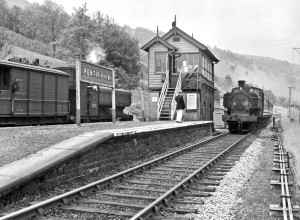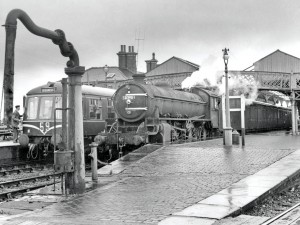Whatever the rights and wrongs of rail privatisation in the UK, no one can deny that, in the period since it happened, the number of passengers being carried has significantly increased. Whilst a very welcome trend, it brings its own set of challenges as the increased ridership has to be managed by greater capacity in the form of either more trains or longer trains, although in practice it will come from a mixture of both.
There is much publicised activity going on with orders for new trains, many of which
are being delivered. On South West Trains (SWT), a different approach is being pursued as redundant ‘Juniper’ carriages from the erstwhile Gatwick Express stock (class 460) have been transferred to SWT to lengthen the Class 458 trains. Now re-instated after reliability problems, these are mainly operating on the Waterloo – Reading lines. Currently these trains are four coach units but the additional carriages will increase this to five.
With longer trains comes the problem of platform lengths. It can be an expensive business to lengthen them and this may also involve having to re-site signals and other lineside infrastructure. Some stations may be constrained between, say, a tunnel mouth and a level crossing so longer platforms become physically impossible to achieve. Lightly used stations can pose a problem as the cost of lengthening platforms may be hard to justify.
Selective door opening (SDO) could be the solution, with an automated system which will only allow the guard to open doors that are actually stopped in the platform. On some TOCS, the relevant doors will automatically release when the train is proven stopped in the right platform. Travellers have grudgingly got used to the automated on-train announcements which ask them to change carriages before alighting from the train.
So how does selective door opening work and how is this impacting SWT?
Developing Tracklink
Issue 58 of The Rail Engineer (August 2009) included a description of the development of selective door opening technology by Hima- Sella, a Stockport-based company specialising in interactive track-to-train communication technology. Early systems were installed on the South East Networker fleet but never commissioned because a revised train service pattern obviated the need for 12-car trains.
A Tracklink I system was developed from this and partially installed on the SWT Juniper fleet to replace the guard having to do door controls at some short-platform stations. Again, it was never commissioned as the trains were suffering from reliability problems and had to be taken out of service. The next application was on the Southern Railway Electrostar fleet using a new generation of equipment – Tracklink II – and has been successfully deployed. However, the quite large track loops, similar in size to TPWS (train protection and warning system) grids, have never been popular with the permanent way engineer as they tend to interfere with the operation of track maintenance machines.
Hence a Tracklink III has been developed, the first customer being London Underground in readiness for the introduction of the S Stock on the Sub Surface Lines. With the complication of the fourth rail, mounting the track beacon between the running rails was impractical so a side mounted configuration has been adopted, usually on the platform wall, necessitating readers to be installed on both sides of the train.
With a single type of train being deployed on these lines, this did not present too much of a problem. The same logic cannot be applied to SWT and a reversion to track mounted beacons and undertrain readers is being adopted.
A new design of beacon was developed and 75 were installed at locations on the Reading- Waterloo line between Nov 2011 and Feb 2012. However, the beacon was found not to be strong enough to withstand everyday track maintenance conditions and a number of the partially encapsulated electronic
tags were smashed. A revised design was therefore produced with the tags being fully encapsulated, 20 of these being installed for a second trial between Feb and May 2012 that has proved successful.
Inside Tracklink III
The system works by siting the unpowered beacon with its electronic tag at the entry point to every platform. Where reversible lines exist, a beacon is positioned at each end. Every beacon is coded with a unique identifier for that platform using a 60-bit code made up of:
» Application code – 9 bits
» Station identifier (3 letter code) – 15 bits
» Platform number – 5 bits
» Platform length – 10 bits, covering from 0 to 1023 metres
» Correct side door enabling (left or right) – 2 bits
» Approach direction (Up or Down) – 2 bits » Selective door system operative – 1 bit » Check bit code – 16 bits.
Once a beacon is coded for a parti![DSCF6021 [online]](http://railengineer.uk/wp-content/uploads/DSCF6021-online-300x225.jpg)
Power for the electronic tag is derived from the radio signal transmitted downwards by the train, the signal transmit frequency being in the 865.7 to 867.9MHz band using frequency hopping radio identification technology. Power levels are low so no radio licence is required and the trials have confirmed that there is no over-read from adjacent tracks. At 75mph, 25 ‘reads’ are achieved between the train and the beacon. At slower speeds, as would be expected from a train about to stop at a station, proportionally more ‘reads’ will be obtained. The system is capable of successfully reading up to 120mph but such line speeds are not available on SWT tracks.
The trial period of 67 days had 45 days of rain and the beacons were also subject to the accumulation of brake dust, grease and general lineside dirt. No adverse impact on system operation was found. Three types of beacon are available, i) for E-Clip sleepers, ii) for Fastclip sleepers, iii) for timber sleepers. Each is a slightly different length and weight but the electronic tags are identical. The GRP beacon casing is made by Vortok, based in Plymouth, and the electronic tag has been designed and manufactured by Hima-Sella in Stockport.
Deployment
A selective door opening system requires co-operation between Network Rail, the train operator and the vehicle manufacturer, which in turn means the letting of multiple contracts. It requires all parties to be satisfied that the system is robust and fit for purpose, hence a prolonged approval process which took until Oct 2012. SWT took a management view that it needed to equip both the Juniper and Desiro train fleets as neither are dedicated to specific routes. In turn, this has meant laying beacons at a large proportion of its stations. Each beacon is around 1.2 metres long and supplied to Network Rail for installation by permanent way staff with signal technicians checking that they are in the right place. A total of 514 (plus spares) are to be installed and will be done in three phases, all of which Hima-Sella has to supply by August 2013.
Train operation and fitment
Fitting the trains with underfloor readers has brought its own challenges. The Siemens Desiro trains of Classes 444 and 450 have a modern Train Management System (TMS) that services the whole unit and thus a reader has only been fitted to every cab vehicle. The reader picks up data from the beacon and enters this into the TMS via an RS485 communication port. All readers are active but only one is needed to acquire the platform information. The TMS will then know where the train is, if it is due to stop at the station, which side the platform will be and which doors to release if it is a short platform. The stopping accuracy by the driver is based upon ± 2 metres from the platform marker point. A total of 344 readers are being supplied for the Desiro fleet, these being fitted at the Northam depot near Southampton.
The Class 458 Juniper trains from Alstom are an older design with only a limited TMS which is already full and would be expensive to upgrade. Thus it has been necessary to fit every carriage with a reader, which will include the additional carriages to be inserted to make the 5 car unit. The operation will be different; each reader will connect to that carriage door control and every carriage that passes over the entry beacon will have the door opening enabled. Thus the positioning of the beacon and the stopping point of the train becomes more ![Tracklink 3 [online]](http://railengineer.uk/wp-content/uploads/Tracklink-3-online-248x300.jpg)
Although not currently used, correct side door opening can be derived from the beacon data. A total of 180 readers will be required (36 five-car trains) and these
are being supplied to Alstom’s Wolverhampton premises before being fitted by Wabtec at Doncaster, the company which is carrying out the five-car conversion.
The readers are powered by the standard 110V DC train supply to RIA 12 and 13 spec and conform to EN50121 and 50155 for EMC limits.
The whole project is scheduled to be completed by Dec 2014 and will be a lot less expensive than lengthening platforms. The Tracklink III specification is likely to become a de facto standard for SDO, this being needed to avoid duplicated fitment if different TOCs operate services across the same piece of railway. Similar circumstances are about to be encountered on London Overground where the intended lengthening of trains to five-car units will cause problems at some stations.
Such is the price of successfully carrying more and more people.


![DSCF6052 [online]](https://rail.images.railuk.com/wp-content/uploads/DSCF6052-online.jpg)
![DSCF6019 [online]](http://railengineer.uk/wp-content/uploads/DSCF6019-online-300x225.jpg)
![Image1 [online]](https://images.rail.co/wp-content/uploads/Image1-online1.jpg)
![Overhead electrification at Crystal Palace [online]](http://railengineer.uk/wp-content/uploads/Overhead-electrification-at-Crystal-Palace-online-300x177.jpg)
![Image2 [online]](http://railengineer.uk/wp-content/uploads/Image2-online-225x300.jpg)


![Rail Ad Feb 13 no text [online]](http://railengineer.uk/wp-content/uploads/Rail-Ad-Feb-13-no-text-online-211x300.jpg)
![Class 222 010_Meridian_ in East Midlands Trains livery[2]](http://railengineer.uk/wp-content/uploads/Class-222-010_Meridian_-in-East-Midlands-Trains-livery2-300x225.jpg)
![David Higgins, chief executive [online]](https://rail.images.railuk.com/wp-content/uploads/David-Higgins-chief-executive-online.jpg)
![shutterstock_127103108 [online]](http://railengineer.uk/wp-content/uploads/shutterstock_127103108-online-189x300.jpg)
![A006_C012_0226H7_S000.0000000 [online]](http://railengineer.uk/wp-content/uploads/A006_C012_0226H7_S000.0000000-online-300x158.jpg)
![Super streamlined train in tunnel [online]](https://images.rail.co/wp-content/uploads/Super-streamlined-train-in-tunnel-online.jpg)

![Motion blur high speed train in subway [online]](http://railengineer.uk/wp-content/uploads/Motion-blur-high-speed-train-in-subway-online-300x179.jpg)
![Construction Train [online]](https://images.rail.co/wp-content/uploads/Construction-Train-online.jpg)
![Track laying train [online]](http://railengineer.uk/wp-content/uploads/Track-laying-train-online-300x179.jpg)
![Aerial View of Al Mirfa site. [online]](http://railengineer.uk/wp-content/uploads/Aerial-View-of-Al-Mirfa-site.-online-300x221.jpg)
![SBOB-20FEB-005 [online]](https://rail.images.railuk.com/wp-content/uploads/SBOB-20FEB-005-online.jpg)
![SBOB-20FEB-208 [online]](http://railengineer.uk/wp-content/uploads/SBOB-20FEB-208-online-885x1024.jpg)
![SBOB-20FEB-218 [online]](http://railengineer.uk/wp-content/uploads/SBOB-20FEB-218-online-872x1024.jpg)

![UKSTT Rail New Install 3 [online]](https://images.rail.co/wp-content/uploads/UKSTT-Rail-New-Install-3-online1.jpg)
![UKSTT Rail New Install 2 [online]](http://railengineer.uk/wp-content/uploads/UKSTT-Rail-New-Install-2-online-225x300.jpg)



![Beeching(4B)(BruceMcCartney)[online]](http://railengineer.uk/wp-content/uploads/Beeching4BBruceMcCartneyonline-300x194.jpg)
![Beeching(5)(RogerHepworth)[online]](http://railengineer.uk/wp-content/uploads/Beeching5RogerHepworthonline-300x212.jpg)